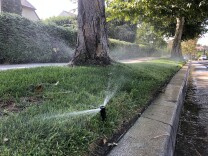
Next Up:
0:00
0:00
-
Listen Listen
Climate & Environment
Expect the warmest and windiest day of the week.
Sponsor
More Stories
-
Temperatures will be well below average, with the chance of thunderstorms in some areas.
-
Warehouse workers who work in hot indoor environments say the climate crisis is moving faster than much-needed indoor heat regulation.
-
The last time one of the animals was seen in California was in 2008, and prior to that the most recent sighting occurred in 1922.
-
A new report says a 75% cut in plastics is needed to limit global warming to 1.5 degrees Celsius.
-
A deep marine layer and strong onshore flow mean that clouds will stick around.
-
The state extended a drought regulation banning using drinkable water to irrigate grass at commercial, industrial and institutional properties.
-
Expect patchy fog this morning and clouds throughout the day in the Los Angeles basin, with highs in the mid-60s.
-
To best protect wetlands, permitting and enforcement need to be sorted.
-
A state program is providing needed funding to help the most impacted and underserved communities adapt to climate change. It could serve as a model for new federal climate spending.
-
Most areas will stay in the mid-60s, but the Valleys will see highs in the low 70s.
-
Environmentalists say it’s past time for California water officials to halt Los Angeles’ diversion of Mono Lake’s tributaries. But L.A. officials insist that water is a tiny but vital part of the city’s water supply.
-
It's going to be cool and cloudy this morning throughout Southern California.
Landfills are the second-largest source of methane emissions in California. That’s why the California Air Resources Board took action to monitor and capture landfill gases.
Support your source for local news!
In case you missed it
-
911 recordings obtained by LAist shed light on why and how emergency planning continues to leave people with disabilities behind.
-
LAist investigates illicit dumping at three Antelope Valley sites.
-
An LAist investigation found toxic heavy metals in samples of fire retardant collected from the Palisades, Eaton and Franklin fires. Here's what that means.
More Stories
-
Extreme wildfires have destroyed about one-fifth of all giant sequoia trees. To safeguard their future, the National Park Service is planting seedlings that could better survive a hotter climate.Listen 6:47
-
Scattered showers and a look ahead to more rain by the end of the week.
-
Aerosol pollutants have masked the effects of global warming. Without them, the U.S. is about to get a lot wetter.
-
A new report finds that one in four people in the U.S. are breathing unhealthy air as rising temperatures and bigger fires create a "climate penalty."
-
For children living near U.S. highways, a transition to zero-emission electric vehicles will mean reduced exposure to dangerous exhaust.
-
A lot of it runs out to the ocean, but we do manage to capture hundreds of thousands of acre-feet a year.
-
The state's parks department is working with stakeholders, including the military, to rebuild the San Onofre road, but no timeline has been given.
-
Built in 1951, the glass-walled chapel is one of L.A.’s few national historic landmarks. This isn’t the first time it has been damaged by landslides.
-
Temperatures rise slightly with clouds sticking around.
-
The dream wedding venue for many had to temporarily close because of damage caused by the Rancho Palos Verdes landslide complex.




































